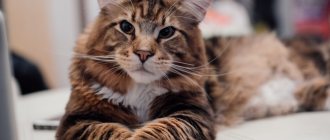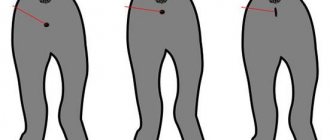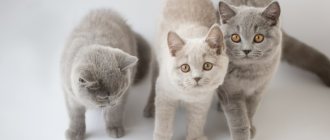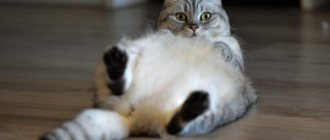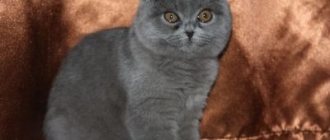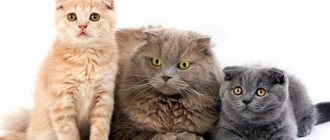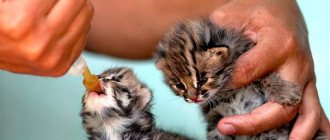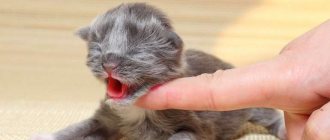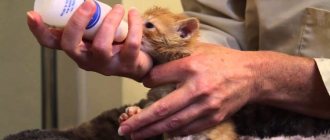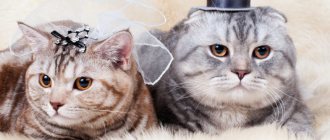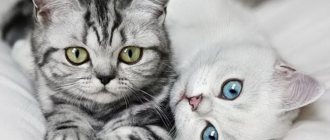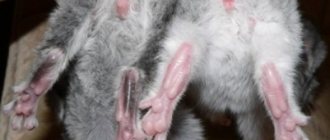If a person is interested in purchasing newborn fold kittens, then it is important to find out information on how to correctly determine whether a Scottish fold kitten is lop-eared. After birth, it is difficult to distinguish whether a cat is a fold cat or not. Unscrupulous breeders try to sell straight-eared pets to unknowing buyers for a high price. To avoid being deceived, it is recommended to study the main differences and recommendations for choosing a cat.
Straights and folds
The Scottish Fold cat breed, characterized by ears with an abnormal structure, became known in the first half of the 60s of the 20th century.
It appeared a little earlier, but did not immediately deserve the attention of scientists. In the 60s Thanks to scientific research, it was found that lop ears appear due to a gene mutation.
By crossing two identically fold-eared individuals, as scientific experiments have shown, it is almost impossible to get healthy kittens with the same unusual ears. The offspring are weak, non-viable, and have many genetic defects.
To get a healthy Scottish Fold kitten, breeders resort to tricks. They cross a fold-eared individual (Scottish Fold) with a straight-eared Scot (Scottish Straight). These breeds are considered related, but at the same time they are independent. The offspring from such a union turns out strong and healthy.
The birth of a viable kitten that meets the standards of the Scottish Fold breed is possible if its parents have the following characteristics:
Why is September a healthy and happy month for cats? Why does a cat bang its head against you in the evenings? 5 “exotics” that are best not to have at home What should you do if your cat sleeps with its eyes open?
- flexibility of the tail (the key to a healthy spine);
- uniformity of color, which should be the same in females and males;
- having ear folds.
The offspring born from the “correct” parents can either have the ear structure typical of Scottish Folds or be straight-eared, like Scottish Straights. It is not possible to determine this in the first weeks of a baby’s life. Fold does not appear until kittens reach three weeks of age. The ears of straights and folds at this stage of development have the same appearance.
This is interesting: Do cats grow whiskers?
What to do if maternal instinct is violated?
If the cat was very exhausted from childbirth, or when the last one was frankly difficult and unsuccessful, your pet may simply not have the strength left to care for her offspring. In these cases, the role of “nanny” will have to be taken on by the owner himself.
We have already described above exactly how cats do this in natural conditions. Remember that you need to “imitate” maternal care as carefully as possible, without rushing.
So, the following is required of you:
- Gently remove the remaining membranes, wipe the kitten's nose and open the mouth, then slightly tilt the pet's head down and try to remove all the liquid and mucus from there.
- If the cat has not chewed off the umbilical cord either, measure about two centimeters from the kitten’s navel, tie the umbilical cord with silk thread, and then cut the “lace” (of course, over the knot you tied). The stump must be lubricated with alcohol tincture of iodine. Please note that you cannot simply cut the umbilical cord! We have already written that when a cat bites it, it simultaneously crushes the edges of the organ, thereby preventing the development of bleeding. If you simply cut the umbilical canal, your baby may bleed to death within minutes.
Experienced veterinarians advise using a urinary catheter connected to a regular syringe. In addition, you can massage the kitten’s throat, trying to induce a cough (if you’re lucky, the animal itself will spit out all the excess).
Rocking is another simple, but still quite effective method of resuscitation. To do this, place the kitten in your palm with its back facing down and squeeze its head (gently) between your thumb and index finger. After this, it is necessary to rock the baby for about five minutes, and at this time the hand should make movements like a rocking cradle. During motion sickness, fluids entering the respiratory tract will fluctuate and irritate the corresponding receptors. The latter stimulate coughing and, if the kitten is lucky, it will spit out all the excess.
Keep in mind that you shouldn’t pretend to be a centrifuge with your hand: you certainly won’t do anything better for the baby, but it’s quite possible to cause a hemorrhage in the cerebellum.
External signs of lop ears
A fold-eared kitten has structural features of the entire body, and not just the ears. These include:
- The nose is without humps, which can be determined by touch.
- The tail is smooth, without humps or knots.
- Wide muzzle.
- Round head.
- Small cheeks.
- Wide eye set.
- Large chest.
- The legs and tail are shorter and larger than those of their straight-eared counterparts.
- Plush wool.
External signs of fold-eared cats
Interesting! Fold cats are long-haired - Highland Folds, and short-haired - Scottish Folds.
Types of British and Scottish cats
Highland fold
Scottish fold
Lop or not?
When the kitten reaches 3 weeks of age, signs of lop ears begin to appear:
- in Straight, there is a hardening of the ear cartilages necessary to support the erect shape of the ear;
- In the Fold, the cartilage tissue does not harden, and the baby develops characteristic ear folds.
The owner of a Scottish Fold kitten should be aware that the ears of a Scottish Fold can rise with age. If they are straight in a three-week-old baby, there is no hope of their lowering. No matter what ears nature bestows on your pet, you should take care to create favorable conditions for its growth and development and choose the right food for the little Scotsman. Taking care of your baby will help him grow up strong, healthy and cheerful.
General information about fold-eared breeds
The history of the breed began in 1961, when an unusual white cat, Susie, was discovered on a farm in Scotland. The tips of her ears were bent forward and covered the upper part of the ear canal.
Susie later gave birth to kittens, two of which (a boy and a girl) inherited a genetic ear abnormality from their mother. The cat was castrated, so he did not leave offspring. And a cat named Sans was purchased by William Ross, who lived next door.
Ross brought geneticist Pat Turner into the matter and the two of them began breeding a new breed. Local British cats were used as partners for Sans, and as a result, 76 kittens were born. Of these, 42 were born with fold ears, and 34 with ordinary ears. This was enough to write an application for the creation of a new species. But life made its own adjustments.
In 1971, the registration of fold-eared cats was canceled. The animals exhibited diseases of the bones, spine, deformities of the limbs, deafness, a tendency to infectious diseases, and much more. It is possible that the story of the Scots could have ended there, but the situation was saved by geneticists from the USA. The problem was solved quite simply. All diseases turned out to be a legacy of the connection between homozygous cats (having the same alleles for lop-earedness). As soon as they began to be bred with straight-eared Scots (heterozygous), healthy kittens were born.
In 1978 the CFA gave the Scots show status. It took another 15 years to establish the standard of the new breed, which was called the Highland Fold (the first cats were long-haired). Later, shorthaired fold and straight-eared Scottish cats were recognized. They became Scottish and Highland Straights.
British colors
There is a common misconception that the color of British cats must be blue (gray). However, it is not. A specific color does not distinguish a breed from others. Representatives of this breed have quite a lot of color types, and each of them has its own characteristics.
Chocolate
This type of color is considered the rarest. It can be easily distinguished by its uniform coat, which has a rich brown color.
Blue wool color
This shade is the most common among kittens of this breed. Its difference is pure blue, without gray and silver tints as standard. This is also a popular color for the Scots, which is why the question arises of how to distinguish a British cat from a Scottish one. In this case, everyone should remember that the difference between one breed and another is not the color of the coat.
Tortoiseshell
This coloring is also typical for both the British and the Scots. The differences between a British and a Scottish cat of this color are in the depth of color. Among the Scots it is somewhat darker and deeper.
But this color will help to distinguish between the British Shorthair and Scottish Shorthair cats, because it is found only among the British. The Scottish breed also has a similar color, but it is distinguished by greater precision of lines and depth of the gray part of the color.
Black
Black color is very rare, and therefore its owners are highly valued by cat lovers
It is important that the color is clean, without white hairs and spots - these are considered defective. Both males and females can be black
White
Very beautiful and also quite rare - white color. These pets look very aristocratic. Moreover, they are somewhat different even from their own relatives. They are more flexible and their status is thinner and more graceful. They are the only ones characterized by light yellow, light green and green eyes - this is the main difference in color.
Signs of lop ears
The following rules will help you determine if a kitten is lop-eared with high accuracy and not fall for the bait of charlatans.:
- Choose a kitten that is at least three weeks old. The older he is at the time of purchase, the easier it will be to determine that he is lop-eared. It is advisable to buy a kitten at the age of two to three months.
- Folds not only have unusual ears, but also a slightly different body structure. Their muzzle is wider, with small cheeks, and their eyes are wider apart. The chest is usually larger, and the legs and tail are shorter and thicker.
- Feel the kitten's nose - there should be no hump on the bridge of the nose. You also need to feel the tail - there should be no humps or knots on it.
- Buy a fold-eared cat in the cold season. The fact is that folds have an interesting feature - in extreme heat, kittens’ ears rise a little.
© shutterstock
In addition, there are some general rules for choosing purebred kittens :
- The kitten must be completely healthy. His fur should be thick and silky, his eyes should be clear, and his tummy should be soft. His mood is also important - if the kitten is healthy, he will be playful.
- If in the future you want to breed purebred kittens or participate in exhibitions, then the kitten you buy must have a veterinary passport and pedigree.
- Since healthy offspring are obtained only by crossing a purebred cat with an ordinary one, you should ask who the kitten’s parents are.
- When buying a purebred kitten, be prepared to pay a high price for it. Such kittens are really expensive, and if the seller offers you to give them away cheaper, this is a reason to think about whether they are offering you defective animals.
By following these rules, you can easily choose a healthy purebred kitten. But do not forget that the criteria for choosing a four-legged friend are not limited to these. After all, each animal has its own character - some are docile, and some are wayward.
To make it easy for you to get along together, carefully monitor the reactions of the kittens you choose. You can determine the cat that is right for you as follows :
- If your baby growls at you, tries to scratch you or run away, it’s better to choose someone else;
- If the cat purrs and sits happily on your lap, this is the beginning of a strong friendship!
Previous
Questions and Answers Why does a cat bite his legs - reasons and what to do
Next
Questions and Answers 7 unusual cat breeds - name, characteristics and description
This is interesting: Instructions for use of the drug Profender for cats
The first months of life of Scottish Fold kittens
In the first weeks of life, kittens go through stages from helplessness and huddling around their mother to independent activity and exploration of their environment.
On day 10, their eyes open: they feel more confident and begin to crawl around the cat. After a month, the kittens are fed food that will be their diet throughout their lives. At the same time, they leave the boxes that served them as shelter during the helpless period of life and master the surfaces. This is a favorable period for training a kitten to use a litter tray.
Color genetics
Kittens' eye color gradually changes: from dull blue to their real color. This process takes up to 2 years and is called reblooming. The inclusions appear first, which then spread and provide a permanent color. Green eyes take the longest to form.
Causes
The main difference between straight ears and drooping ears is the structure of the eardrum. Immediately after birth, kittens are similar to each other. Only after a while the ears either remain hanging and close the membrane, or rise. And sometimes this happens without any outside influence.
The straightening process is affected by:
- climatic conditions;
- stress;
- hormonal disbalance;
- diet;
- physiology.
If a fold-eared cat's ears are straightened, then weather conditions may have had a direct impact. For example, in the heat they straighten and stick out in different directions. A rare position occurs when bending backwards. In some cases, after climatic conditions normalize, a return to its original place occurs. This breed is characterized by excessive sensitivity and reaction to any changes in the weather.
This also happens if the animal is under stress. Often, owners noticed changes at times when the animal became nervous. In most cases, this position of the ears became permanent.
Often, a fold-eared cat's ears will rise after giving birth . Hormonal disruptions that occur in the body also affect lop ears. That is why many breeders participate with their pets at exhibitions only until the first birth, while the ears are hanging.
During the mating process, people sometimes take this process lightly and do not pay due attention to the main reason for straightening - genetic predisposition. If the gene responsible for lop-earedness is not fixed, then even if the kitten is born lop-eared, changes will soon occur.
Also, after incorrect mating and a thoughtless choice of a partner, kittens may not only change the structure of the auricle, but also develop a number of health problems. The consequence of such a mutation can be fusion of the vertebrae or problems with the musculoskeletal system.
If a fold-eared cat's ears are straightened, then the reason may be in the animal's diet and the replacement of frequently consumed food with some other, less familiar food.
( 2 ratings, average 4.5 out of 5 )
On the eve of childbirth
Usually a woman in labor copes with childbirth on her own, but a responsible owner should keep ready everything that may be useful during childbirth: clean towels, disposable diapers and gauze napkins, scissors and thick threads in case you have to cut the umbilical cord yourself, boiled water and a first aid kit, the contents of which should be discussed with your veterinarian in advance.
If your pet is constantly being observed by the same doctor, ask him for a phone number before giving birth in case of unforeseen circumstances or find contacts of a veterinary hospital where 24-hour consultation is available. Also make sure that you can go to the nearest veterinary clinic at any time, which is always open and you know the way to it and its exact address, in case you have to get there by taxi or on your own.
Childbirth is a moment of crisis for any cat and requires control from the owner
If a cat gives birth safely at home, she will eat the afterbirth after the kittens - this is absolutely normal. Some experts believe that it is enough to give the cat the afterbirth of only one kitten - especially if she has problems with the gastrointestinal tract. By the way, if the labor is long, then it is allowed to feed and water the woman in labor - this will give her strength. After giving birth, you need to clean the nest and leave the cat alone - she will have to carefully lick and feed each kitten.
Constant sleep of newborns - an alarming signal or normal development of the body
Newborn kittens sleep up to 22 hours a day. This is not a cause for concern, because at this time the baby’s nervous system is developing. Sleep contributes to the favorable course of this process. In the first months, the kitten should not be separated from its mother and brothers and sisters. If his weight is normal, it means that development is proceeding normally, and constant sleep is conducive to this.
Newborn kittens sleep up to 22 hours a day
You can familiarize yourself with sleep norms for the initial stages of a kitten’s life in the table.
| Age | Image | Number of hours of sleep |
| Newborn | 22 | |
| 3 weeks | 16 | |
| 1 month | 15-20 |
In order for a kitten to switch to nighttime sleep mode, it should be provided with sufficient activity during the day: play, run. Thus, by night he will be tired, sleep will be necessary to restore strength and will coincide with the biorhythms of the owners.
Massage
We emphasize once again that the digestive system of premature kittens is almost always underdeveloped. Because of this, in particular, pets almost always have serious problems with peristalsis. In order to somehow stimulate it, it is necessary to regularly massage the abdominal cavity.
. It should be taken into account that even a cotton pad may be too hard for the extremely delicate skin of a premature kitten.
To avoid injuring the baby, turn on the tap, wait until warm (but not hot) water comes out and, directing it in a thin stream, massage the lower part of the kitten’s tummy, helping with your finger. Before doing this, it won’t hurt to cut your nails (yourself). If the kitten experiences discomfort during the procedure, its intestines will not be activated.
Childbirth in cats, just like in humans, can be unpredictable. On average, a cat bears kittens for 62-72 days. It is believed that premature birth in a cat occurs if the gestation period is less than 58 days. The reasons for early lambing can be different. The owner of the animal should know what to do in such cases.
Genetics of differences between Scottish and British cats
At first, the researchers decided that the unusual shape of the auricle in the Scotsman was the result of an autosomal dominant trait, but later their opinion changed. The dominance turned out to be incomplete. An allele of a gene on one chromosome only masks or changes the instructions of another locus of the same gene to another copy of the same chromosome.
It sounds complicated, but for the Scots this combination almost turned out to be a death sentence - animals of this breed experienced changes in the functions of the musculoskeletal system, and pathologies of the bones and spine also developed.
A little later, American geneticists got involved in the work, and the differences between the British Fold and the Scottish Fold became more specific:
- A pair of fdfd genes is responsible for the normal shape of an animal’s ears. The British and Scots with this “set” are no different from each other.
- The heterozygous Fd fd model (when one of the parents is straight-eared) leads to the birth of lop-eared kittens, but does not have a negative effect on the health of the pet.
- Negative scenario – homozygous set of FdFd genes. In this case, the difference between the British and Scottish breeds will be not only in the shape of the ears, but also in the presence of pathologies of cartilage and bones.
Character
The British are calm animals who do not like active interference in their lives, while they do not impose themselves on their owners. Not big fans of sitting on laps. They are phlegmatic and value solitude. They don’t know how to use it and don’t get into the “meerkat pose.” Smart, self-sufficient, neat, benevolent and discreet animals. They are undemanding in care and handling, loyal to their owners, but do not show much affection. They like to occupy observation positions on top of shelves, furniture, and higher places specially designated for this due to their developed leadership qualities.
Scots require increased attention, are playful and love affection, sometimes they beg for it too actively. They love to sit in a “column”, thus straightening the vertebrae. Height is not tolerated due to the structural features of the skeleton.
What documents should there be?
The purebred Scottish Fold cat, as well as its health parameters, must be confirmed by official documents:
- metric or pedigree;
- certificate of registration (for American organizations);
- purchase agreement;
- veterinary passport;
- transfer to own a cat (in rare cases);
- veterinary certificate No. 1 (for imported animals).
Important! A serious nursery will not sell cheap kittens without documents and expensive ones with documents. From a responsible breeder, all animals have documents issued simultaneously for the litter, which is registered as a whole.
If you receive a metric in your hands, the pedigree is no longer needed, and vice versa. But the breeder is obliged to hand over one of these main papers, regardless of the purpose of acquiring the “Scot” - for breeding or castration.
Documentation of the litter in the breed club is strictly regulated, but is inexpensive. All papers received from the breeder minimize your potential risks: you will always return the animal and the money spent if it is found to have congenital anomalies.
Metrics
This is a birth certificate issued after the animal is registered in the club system. The following must be included in the document (where the emblem of the system to which the “Scotsman” is assigned) is affixed:
- Name;
- date of birth;
- gender and breed;
- color;
- names/colors of manufacturers;
- breeder's name and other information.
The European certificate is affixed with the seal of the club and the signature of the responsible person who activated the litter: this is necessary to exchange the metric for the pedigree. In American systems, a slip (metric) is used to register a kitten and obtain a pedigree through the central office.
Pedigree
This includes the kitten’s ancestors (up to 3–5 generations) with their names, colors and pedigree numbers . This document contains the name of the nursery and club, the association's emblem, information about the kitten, as well as the names of the breeder and owner.
Attention! The “owner” column should contain your name, not the name of the breeder. To do this, obtain a pedigree yourself or agree with the breeder to prepare it in advance.
European pedigrees are provided with a number, the seal of the club and the signature of its leader, American pedigrees - only with a number . Pedigree in the USA is informative, and pedigree is confirmed by registering the kitten (and its litter) in the system according to its rules.
In European associations, you may be given a pedigree without a number or marked “pet”, or not at all if you adopted a “Scot” for castration. If you want to draw up a pedigree yourself (provided you have a metric), do it before the pet turns one year old. If you are not going to breed purebred cats, you won't need a pedigree.
Veterinary passport
Information such as:
- name and gender of the kitten;
- breed and date of birth;
- vaccination records (with a veterinary clinic stamp, a special sticker and a doctor’s signature);
- owner/breeder's name.
Despite the fact that a veterinary passport is issued to every purebred animal, it cannot serve as confirmation of the breed: the veterinary passport is filled out by the breeder or doctor, and clubs and felinological associations are responsible for the purity of the breed.
Other documents
All other documents (certificate of registration of the kitten in the system, transfer of ownership, veterinary certificate in form No. 1) are optional, that is, optional. An exception is a purchase and sale agreement, which will protect your rights if an unscrupulous breeder sells you a cat that is known to be sick.
Important! A Scottish Fold cat without documents is not recognized as a purebred cat and is automatically excluded from breeding.
Determining gender in other ways
There are several other methods for determining whether a kitten belongs to one gender or another. Below we will look at which are reliable and to what extent.
By color
A very reliable method if we are talking about a tortoiseshell kitten: black, blue-cream or patchwork (tri-color) “tortoise”. A tortoiseshell kitten is 99% of the time a cat. This is explained by the fact that all colors without exception are formed by two genes - “black” and “red” (red). Blue and cream colors are “lightened” blacks and reds.
The color gene is always transmitted by the female X chromosome, so there can be no discrepancies in cats: XY - one color, black or red, transmitted by the mother. Cats have two chromosomes carrying color genes: XX - therefore, it is possible to transmit either red or black genes, or both at the same time, which gives the tortoiseshell color.
Tortoiseshell boys are born very rarely, and their color is a genetic deviation (extra X chromosome: XXY - giving the wrong second color gene). Therefore, “tri-colored” cats are born sterile. All other colors are normal for both sexes.
By voice
With a certain stretch, one can consider the method effective: it is believed that cats have more low overtones in their voices, and cats have more high ones. In fact, quite a few cats have a rather gentle contralto voice, and the voices of some cats, on the contrary, sound menacing and not at all feminine.
In the face
It is believed that the outlines of the girl’s face are more subtle and soft, while the “portrait” of the cat is sculpted roughly, with wider cheekbones and the back of the nose. In reality, the method, of course, cannot be considered reliable. “Facial features,” like in humans, are inherited from parents. Which makes it more than likely both the subtle aristocratic features of the cat’s appearance and the harsh features of some four-legged young ladies.
Moreover, there are breeds of cats (a striking example is the Maine Coon), whose breed phenotype obliges them to look like wild, angry predators, regardless of gender. There are also breeds of graceful, fine-boned cats, the characteristics of which are reflected in the features of the males enough to confuse the untrained eye.
By weight
Weight is a criterion by which it is theoretically possible to determine the sex of an animal, but the reliability of the method is very low. It can be considered more or less reliable in two cases:
- If daily control weighings of the litter show a consistently high weight gain of some kittens compared to others (indicators vary for different breeds and individual body characteristics of animals).
- If size and weight are breed-forming characteristics and significantly exceed the values possible for cats, with a high degree of probability the luxurious dimensions belong to the representative of the stronger half. The disadvantage of this method is that by the time they reach the indicative size and weight, the animals have already grown enough to easily determine gender based on anatomical characteristics.
Veterinary method
You can accurately find out the gender of a kitten by contacting a veterinary clinic. If a visual examination by an experienced veterinarian does not allow accurate results (for example, when the length and thickness of a very small kitten’s fur “confuses the indications”), there is always the opportunity to donate blood for a test. It makes sense to resort to this method when it is the only way, and for some reason the result needs to be known urgently.
When do fold-eared kittens' ears droop?
First of all, it is necessary to understand genetic mechanics. Because you won’t be able to immediately understand whether a kitten is fold-eared or not. All babies are born with a normal ear structure and all newborn kittens have erect ears. But by 15-20 days, the ears of lop-eared babies droop. Thus, at 2 weeks of age, kittens first show their belonging to the fold-eared group. But the process is not yet complete and things can change quite quickly.
Initially, all animals were born with one fold, but later breeders were able to achieve the formation of two, and after a while, three folds on the ears of cats. If at 2 weeks of age only one fold has formed in lop-eared kittens, then there is a high probability that later the cartilage will become stronger and the ear will straighten - in such kittens the ears rise in 50% of cases, and they grow not as folds, but straights.
The presence of a double fold is a guaranteed sign that can be used to distinguish a fold-eared kitten from an ordinary one. In this combination, the risk of encountering erect ears is reduced by another half.
The most reliable sign is the presence of a triple fold. With it, the ear will definitely remain pressed to the head. However, it will be possible to definitively determine lop ears in a kitten only at the age of 3-4 months.
Important! Despite the fact that Scots differ from other breeds in the unusual shape of their ears, some animal lovers prefer to have straight-eared Straights. They are afraid of possible health problems and believe that a cat with raised ears has a more affectionate character.
Symptoms
The first thing you need to pay attention to is the general condition and mood of the cat. An unhealthy Scottish Fold will be characterized by lethargy, apathy, lack of appetite, sometimes irritable reactions and unreasonable aggression. The nose becomes dry and very hot to the touch
Perspiration may appear on the fur. When measuring temperature, the readings will exceed 38.5 °C
The nose becomes dry and very hot to the touch. Perspiration may appear on the fur. When measuring temperature, the readings will exceed 38.5 °C.
An unhealthy Scottish Fold will be lethargic, apathetic, and lack of appetite.
In specific diseases, the cat owner can focus on the symptoms.
Table 2. Symptoms of diseases of internal organs
| Type of disease | First symptoms |
| Viruses | Sneezing, discharge from mouth and nose, fever |
| Ear | The cat shakes its head, discharge from the ears (pus, fluid), putrid smell from the shells, redness of the skin in the shells, the cat scratches its ears |
| Ophthalmic | Redness, lacrimation, purulent discharge, swelling of the eyelids of varying degrees, the cat tries to scratch the eyes, poor orientation in space, cloudy pupils |
| Digestive | Refusal to eat, vomiting, nausea, constipation, diarrhea, undigested pieces in feces, increased thirst |
| Skin | Scabies, redness, bald patches, rashes, sores, blisters, peeling, nodules |
| Heartfelt | Shortness of breath, cough, swelling, increased frequency of sighs, low temperature, fainting |
| Genitourinary system | Sudden weight loss, pink urine, apathy, frequent urination, the cat meows when urinating, fussing |
| Bone | Disproportionately large head, crooked, protruding jaw, shortened limbs, curvature of the spine, twisted front legs, joints with a swollen effect, too massive joints, growths on them, slow or absent growth of the cat, shortened thick tail, inactivity, clumsiness of movements, attempts not to bend the paws when moving |
| Dental | Foam, pus, excessive drool from the mouth, bad odor from the mouth, yellow, brown, gray growths on the teeth, brittle teeth, refusal to eat (it hurts to eat) |
In the early stages, 2-3 mild symptoms may be observed. As the pathology develops, the number of manifestations increases. It is necessary to monitor your fold ear and consult a doctor at the first suspicion of abnormalities.
Refusal to eat may indicate health problems in your cat.
Rules for determining lop ears
You can accurately judge the condition of a kitten's ears approximately 2 months after birth.
Fold-earedness in a purebred furry pet is determined as follows:
- It is recommended to determine the age, choose a Scotsman after a month of life, and buy by 8-9 weeks. Then you can finally determine whether the cat was born straight-eared or not.
- The Fold cat looks a little different than the British. It differs not only in the shape of the ears, but also in the structure of the body. The muzzle is wider, the cheeks are small, the eyes are set deeper. It can be seen that the chest area is larger, the limbs are smaller.
- Experienced breeders advise examining which Scotsman has a nose and tail. A purebred cat has no humps or nodules on the bridge of its nose.
- It is better to choose and purchase a fold-eared pet in the cold season, because folds have a peculiarity - in hot weather the ears rise slightly.
How to distinguish a straight-eared cat from a fold-eared one with erect ears?
As we have already said, sometimes over time a lop-eared kitten's ears will rise. Why can cats' ears go up? This is influenced by various factors, including the number of folds. As a result, if a fold's ears rise, it may be considered a straight. This is not particularly important if you do not intend to crossbreed your pet. But if there are such plans, you will have to conduct a genetic examination: folds cannot be crossed with folds, therefore, if your cat is a fold, and you, thinking that he is a straight, pair a fold, the offspring will be sick. At the same time, it is recommended to neuter Folds with mature ears.
Experienced breeders advise those who want to distinguish a Straight from a Fold with erect ears to pay attention to their size. Straights have quite large ears, sometimes even too large. And with folds they are always noticeably smaller.
This is what folds look like with their ears standing up. Please note that the ears do not have sharp tips and are small
Source
Periodization of the kitten's life stages. The first stage - mom is nearby
Kittens grow up to 1 year, during which significant changes occur every month. At the same time, 2-2.5 years is the period when the body finally gets stronger and becomes an adult.
| Age | Image | Peculiarities | Recommendations |
| First week | Weight – 100 g. Body length – 9-12 cm. No hearing until the 4th day. Eyes don't open. Undercoat appears. The umbilical cord separates on the 3rd day | Food is mother's milk, which the baby senses through olfactory receptors and consumes naturally. Antibodies contained in cat milk help an unvaccinated kitten resist infections. Do not disturb the unity of the kitten and the cat, so as not to scare the baby | |
| Second week | Weight - 250 g. By the end of this period, the eyes open; at first, the eye color of all kittens is cloudy blue. Attempts to walk, crawl away from the mother by 30-50 cm. | Stroke the kitten gently. Do not cause aggression on the part of the mother cat, who is worried about the younger generation at their first manifestations of independence | |
| Third week | Weight – 300 – 350 g. Support on 4 legs. On days 15-17 they begin to see. Orientation in distances. First milk teeth. Scratching behind the ear. Interest in playing with people | Play with kittens without sudden movements. Do not leave small children and kittens unattended | |
| Fourth week | Weight – 450 g. Approximately 26 teeth | Organize worm prevention. Drink filtered water from shallow bowls. Provide the kitten with constant access to water | |
| Fifth week | The cat reduces the level of care for the baby. The kitten learns to wash itself. The fur becomes brightly colored | Stock up on age-appropriate liquid food. Include solid foods in your diet. Provide the kitten with constant access to food (100 grams of food is the norm). Do not allow your baby to eat from adult bowls. Organize a pet house |
7-12 months
Stages of further development of Scottish:
7 months. It's time for puberty
When the first shedding occurs, it is important to comb the fur on time and make sure that the animal does not swallow its own hairs. They offer him cat grass and a special hair removal paste. 8 months
Castration and sterilization are carried out. 9 months. Scottish already resembles an adult cat, but he can still continue to be given baby food. 10 months. Animals actively demand “love acquaintances.” However, mating at such an early age is undesirable - the cat’s body has not yet formed for procreation. 11 months. The animal is gradually transferred to adult food. The frequency of lunches is reduced to 3 times a day.
One-year-old “Scots” are no longer growing. However, they continue to develop: gain mass, increase in width, build muscle. This process is completed by 2-2.5 years.
Scottish cats at 9 months:
Photos, videos of Scottish cats at 1 year:
The second stage is independence and growing up
Age Image Features Recommendations
| Sixth week | The final transition from mother's milk to foreign food | Feed the kitten 6 times a day, 40 grams of food at each meal. Observe the animal's stool; if there are any problems, contact a veterinarian after 3 days. |
| Seventh week | Weight – 550-900 g. Males stand out among females in size | The kitten should not drink its mother's milk. Balance of dry and liquid food |
| Eighth week | Weight – 750 – 1200 g. All milk teeth. Eats solid food | Separate from mother. Get examined by a veterinarian. Monitor the condition of your ears and eyes. Comb |
| Ninth week | Forming a type of relationship with the owners | Get vaccinated |
| Tenth week | Weight – 850-1400 g. Independence. Sensitivity to learning | Do not be aggressive in training |
| Eleventh week | Research stage: exploring the corners of the apartment | Prevent the kitten from colliding with dangerous objects: close windows, remove small parts, toxic substances |
| Twelfth week | Weight – 900-1600 g. Change of eyes Pet’s response to its name, to the call for food | Organize repeated prophylaxis against worms. Stop kitten aggression |
| Thirteenth - fifteenth weeks | Weight – 1.5 kg. Molars appear | Feed 5 times a day. Trim nails regularly |
| Sixteenth week | Weight – 1.8 kg | Get vaccinated |
| Five months | Weight – 2 kg | Feed 4 times a day. Get a rabies vaccination |
| Six months | Strong molars. Dimensions of an adult animal. Puberty | Organize worm prevention. Feed 3 times a day. Sterilize if there is no goal to breed offspring |
| Seven months | Seasonal molt | Brushing your pet |
| Eight – nine months | The cat is almost an adult | Sterilize if not done before. Consult your doctor about vaccination |
| Ten – eleven months | Adult phase of life | Include food for adult cats in the diet |
Cat vaccination periods
Important! When the cat turns one year old, his diet should consist only of food for adults, and meals should be reduced to 2 per day.
Adding to the family: how to care for a mother and her newborns
In the first weeks of life, kittens go through stages from helplessness and huddling around their mother to independent activity and exploration of their environment.
On day 10, their eyes open: they feel more confident and begin to crawl around the cat. After a month, the kittens are fed food that will be their diet throughout their lives. At the same time, they leave the boxes that served them as shelter during the helpless period of life and master the surfaces. This is a favorable period for training a kitten to use a litter tray.
Color genetics
We invite you to familiarize yourself with the Scottish Fold cat photo smoky
Kittens' eye color gradually changes: from dull blue to their real color. This process takes up to 2 years and is called reblooming. The inclusions appear first, which then spread and provide a permanent color. Green eyes take the longest to form.
( 2 ratings, average 5 out of 5 )
How to choose the right one?
There are some recommendations and rules for choosing purebred Scots:
- The animal must be healthy with dense hair, clean eyes and a soft belly to the touch.
- Real folds look cheerful, playful and content.
- It is necessary to have a pedigree and a passport of the animal, especially for its participation in exhibitions and competitions.
- It is necessary to find out from the breeder who the kitten’s parents are, since their genetics affects the health of the babies.
- A real fold-eared cat will have a high cost. If a seller sells a pet cheaply, then you need to think about whether it is defective.
By following these rules, you can easily choose a pet with good health. If you want to make an affectionate, gentle, playful friend, following all the recommendations, this breed is better suited. In order to quickly and easily make friends with your pet, you need to carefully watch the reaction and behavior. It is possible to determine a suitable cat this way: if it does not attack a person, does not snort, and does not try to run away. If a lop-eared pet purrs, then this is a sure sign of the beginning of friendship between him and the future owner.
This characteristic of the Scottish cat breed will help you get your bearings and understand whether they are really offering you a real purebred kitten or a mestizo. But first, a photo, because it’s better to see once than to hear seven times. Let's see what a Scottish fold and straight-eared cat looks like and a real fold-eared cat.
Features of the care and maintenance of “Scots”
Scots are an unpretentious breed, which, however, requires special care. Caring for Scottish cats is not difficult, but it has its own specifics that you need to know about.
Coat care
Akita Inu: description of dog breed, character
Plush fur does not require special care, but a cat that lives in an apartment and is warm all year round may be constantly shedding. There is no pathology in this, it’s just that the cat’s body does not grasp the system of changing seasons.
Due to constant shedding, a cat's fur requires regular brushing. If this is not done, tangles may form that cannot be removed with a comb.
For express shedding, you can contact a groomer. The cat groomer will comb your cat and tell you how to care for its fur. For combing at home, it is best to use a furminator. It makes it much easier to remove excess hair.
For reference! Dry air can also lead to heavy, constant shedding. In this case, buying a humidifier will change the situation.
Bathing
Cats are very clean animals and do not require special water procedures. Bathing is very stressful for a cat.
You only need to wash a Scotsman if he has gotten very dirty in something.
Important! After washing, the cat must be dried thoroughly. If this is not done, the kitty may catch a cold.
Dental care
The Scots do not require any special dental care. But some cats can develop plaque that develops into tartar.
To prevent these conditions, you can give hard treats that remove plaque from the teeth. Also, cats with a predisposition to the appearance of plaque and stone are recommended to visit the veterinarian once every six months. In advanced cases, the stone is cleared using an ultrasound scaler under general anesthesia.
Eye care
The Scottish cat has a short, flat face, so drooping eyes are normal for Scottish cats. This is called "brachycephalic syndrome."
Normally, tears, moistening the eye, should flow into the nasolacrimal duct. In Scots, due to their short muzzle, the nasolacrimal duct may be deformed or completely closed. Therefore, tear fluid overflows over the edge of the eyelid, and smudges appear under the eyes.
If your pet has this problem, the best solution is to use a special eye wash lotion. Instead of lotion, you can use boiled water or aqueous chlorhexidine.
Important! You cannot use tea leaves to wash your eyes, as the tea leaves contain microorganisms that can form pathogenic microflora in a cat’s eye.
Nail care
Some Scottish cats have uncontrollable nail growth and this needs to be monitored. Normally, when using a scratching post, the cat removes the top layer of its claws, thereby grinding them down. But some Scots neglect the scratching post (perhaps due to joint pain).
If an ordinary cat can have its claws trimmed only when necessary, then the Scottish paws need to be given attention monthly. If this is not done, the claw will bend and dig into the paw pad with its sharp part, causing pain to the animal.
To properly trim a Scotsman's claws, you need to press the cat's finger from above - then the claw will “come out” of the paw, and cut off its tip to the pink border.
Important! If you accidentally touch the pink part of the claw, you can damage the vessel. To stop bleeding, hydrogen peroxide or potassium permanganate in powder form is used.
Nutrition
Scots are usually not picky eaters and choosing food is not difficult. A proper diet helps the cat’s body maintain immunity, prevents urolithiasis and eating disorders.
With the purchase of a Scottish cat, the owner is faced with the question of what to feed the animal. The choice has to be made between a natural diet and ready-made food. When deciding to feed an animal natural food, it is necessary to create a diet. To do this, you need to visit a veterinary nutritionist.
From food the cat should receive:
- proteins;
- carbohydrates;
- fats;
- minerals;
- essential amino acids;
- fiber;
- vitamins;
- macro- and microelements.
Important! Only a specialist can choose the right diet! Feeding your cat "from the table" can lead to digestive problems.
Feeding commercial food saves the owner from preparing food specifically for the cat, and it is also more economically profitable. All the necessary elements are already in the food, in the best combination. The owners just have to calculate the portion. A hint about the amount of food per day is always on the back of the pack.
Food is divided into classes: economy, premium and super-premium, and also comes in the form of dry food, spiders, canned food and mousses. More or less good food starts from the premium class.
Economy food contains too few nutrients, and the cat must eat too much to be satisfied. Sooner or later this will lead to obesity.
It is impossible to say unequivocally that some food is good and some is bad. There is food that is suitable for a particular cat, and if there is one that will only cause the animal to become upset.
Puberty in cats
In a Scottish pet that comes into the family at the age of 3 months, sexual maturation can begin early, at 4.5 months. Physiologically, a Scots kitten will gain strength only after 9 months or later. The reproductive period, the gestation period comes after 10 months, lasts on average until 7-8 years of age. Premature pregnancy is harmful to the kitten’s fragile body.
The cat is in heat
Scots are a breed with average sexuality, so during the period of heat, many do not arrange unbearable concerts. The period of the first and all subsequent heats is difficult not to notice; within 3-4 days, the imperturbable Scottish woman’s behavior changes dramatically. She becomes either too affectionate or restless, runs after family members, and constantly makes sharp “meowing” sounds. Begins to mark the surrounding space around. These cat days are called estrus, rut, or hunting.
According to the nature of its passage, estrus can be divided into periods:
- The first one goes quite calmly. The cat develops small transparent discharge from its intimate parts, signaling the onset of estrus;
- In the second period, the character changes dramatically, the cat constantly screams heartbreakingly, emitting different sounds, calling out the cats. She may not eat, constantly raising and lowering her tail, periodically rolling on the floor or raising her butt.
- After a few days, she calms down and gradually returns to normal.
Duration of pregnancy
A cat's pregnancy lasts on average about 9 weeks. A more accurate period depends on many factors such as age, weight and breed characteristics. For example, owners have found that the process of bearing offspring in short-haired females lasts 58-68 days, in cats with long and medium-length hair it lasts 63-72 days.
How many kittens can a cat give birth to?
The length of pregnancy is also affected by the number of babies inside the womb. The more there are, the earlier the due date will come. Females bearing one to two kittens are able to walk for as long as possible before giving birth. In addition, their health depends on the number of cubs. Statistics show that babies from multiple litters are weaker and sicker.
For your information! In one litter, a female can bring from 2 to 8 kittens, the exact number of which depends on many factors.
